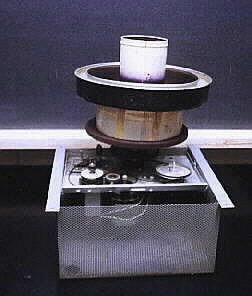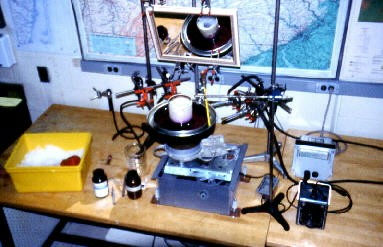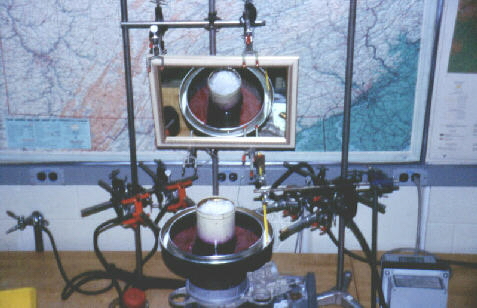Jet Stream Apparatus
The jet stream apparatus consists of a horizontal set of three circular pans which are nested one within the other, are partially filled with water, and are rotated around a vertical axis. The center pan is cooled by adding ice, and the outer pan is heated by four Bunsen burners which direct their flames on the outer edge. The photograph below does not show the Bunsen burners which are used for heating. The experiment occurs within the liquid of the middle pan which is being heated at the outer edge and cooled on the inner edge, while being rotated. The outer pan corresponds to the equator, the inner edge corresponds to the pole, and the rotation corresponds to the rotation of the Earth.

The apparatus shown above is the most recent jet stream model. I used a reel-to-reel tape recorder body as my base for the apparatus. This tape recorder was discarded from the former language laboratory of Moravian College. The leveling screws at the front corners (and a third, not visible, at the center of the back edge) allow the device to be made horizontal. Inside the tape recorder body, not in view, is a variable-speed motor which is connected by a rubber belt to a disk drive from a discarded main-frame computer. I machined a brass ring to fit on top of the disk drive and to support the horizontal pans well away from the four Bunsen burner flames that heat the outer edge of the outer-most pan. The inner-most pan is taller than the others so it can hold a significant quantity of ice. The pans are part of a wedding cake pan set.
The apparatus shown below is an earlier version of the jet stream apparatus. The base is, again, an old reel-to-reel tape recorder from the Moravian College language laboratory, and the cake pans are the same as those used in the apparatus above. However, the AC motor of the tape recorder was used to spin a small plastic post that was connected to a dial from an old radio via a belt that came from an old 8 mm movie projector; the dial in turn was connected via another belt to the disk-shaped chopping wheel of the same old 8 mm movie projector. In this way I reduced the rapid spin of the AC motor to the much slower spin needed for the experiment.

The major problems with the apparatus in this earlier version were the fragility of the mount on which the pans were balanced and the frustration with trying to vary the speed of the AC motor of the tape recorder with the variac because the AC motor was designed to NOT vary in speed. The later, improved version of this equipment solves both these problems by employing a rugged computer hard-drive axis to hold the pans, and substitutes a motor which spins less quickly and is designed to be varied in its speed output.
Whether in the older or the newer version, the device simulates the jet stream circulation of the Earth by developing similar circulation patterns on the surface of the water within the center pan. Dye placed in the water shows the circulation below the surface and graphite flakes which float on the water surface show the loops that develop there. A counter-clockwise spin simulates circulations within the northern hemisphere. Variables that can be investigated in the model are (1) the depth of the liquid, (2) the thermal gradient, and (3) rate of rotation. Because there are only integer numbers of possible loops, the looping patterns will change from 3 to 4 to 5 to 6 or more, similar to the behavior of the jet stream on the Earth during the different seasons of the year.
The photograph below shows the newer version of the jet stream apparatus set up in the laboratory, with the electrical controls for the motor rotation, four Bunsen burners, a thermometer for measuring the temperature in the outermost pan, and a mirror suspended above the pans to make the viewing of the loops more convenient. The yellow bucket contains ice which is placed in the center pan to act as a heat sink, similar to a polar region of the Earth. At the time the photograph was taken, the apparatus was operating and the Bunsen burners were heating the outermost edge. Notice that the four Bunsen burners are located near the back of the apparatus, rather than being evenly distributed around it. This is done to better insure that students do not get their hands or hair too near the flames.

This photograph shows more detail of the dishes, both in the normal and reflected views. Potassium permanganate (KMnO4) has been added to the water of the pan in which the experiment takes place to tint the water a purple color so the graphite flakes that float on its surface can be seen in better contrast. The KMnO4 also acts as a tracer to reveal circulations below the surface of the center pan.

The photograph below shows a close-up of the pan and its reflected image in the mirror. In the mirror image, four loops can be seen by the pattern of graphite flakes on the surface of the water, which is colored purple by the KMnO4.
